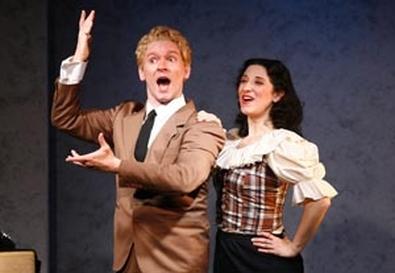
Whatever else you can say about it, YouTube is an archive of videos of long-dead actors, viewable on demand. So if you're unfamiliar with Danny Kaye, who died in 1987 and was a supreme comic talent, enjoy the banquet. There's Kaye playing the Swedish Chef's uncle on The Muppet Show, romping through "the pellet with the poison" routine in the film The Court Jester, and prevaricating away on the game show What's My Line?, among many other things.
With book and lyrics by Robert McElwaine, original music by Bob Bain, and direction by Pamela Hall, this tuner covers less ground than Martin Gottfried's biography, Nobody's Fool, but dances around its edges: How did Brooklyn's David Daniel Kaminsky become Danny Kaye, and why did bitterness set in? The show covers only the years 1936 to 1948, when Kaye met and married ruthlessly ambitious songwriter Sylvia Fine, who became his manager, specialty-material creator, and Svengali. That the era coincided with Kaye's rise from Catskills tummler to stage and screen star is unquestionable. The question is what the authors would have us believe about the titular pair.
But before we get to that, let's salute the performers. Is Brian Childers' soul owned by Kaye's spirit? Watch those limbs! His physicality is so like Kaye's it's a see-it-to-believe-it experience. Childers can dive into gibberish and do accents like Sid Caesar; he gambols, pivots, yelps, frolics, leaps, squeaks, and giggles. He acts, too. While his voice is rougher than Kaye's, he's a charmer.
Kimberly Faye Greenberg not only resembles Fine; she radiates her fearlessness. Her Fine isn't likable (neither was the real one, they say), but Greenberg reveals heart beneath Fine's heartlessness plus compassion for her comic-savant husband.
The actors also save the show from its lack of scope. There's nothing untoward about creating an original score to dramatize the trajectories of Danny and Sylvia, but their backstories—explored in Gottfried's book and other sources—are what make them compelling. Few of the 21 new songs freight such narrative. The score treads too lightly.
Per Gottfried, we know this was no marriage of pure love. It was love driven by pure lust for public adulation, which Kaye achieved and Fine notably did not. McElwaine and Bain needn't dramatize rumors of Kaye's sexuality, but they shouldn't scrub his life with anti-bacterial soap either. Ah, but underneath: McElwaine, says his program bio, was director of advertising and publicity for the Goldwyn Studios in the 1950s and Kaye's "publicist and confidant for 20 years." Hence, why Danny and Sylvia is like a YouTube video: talent slices atop a two-act toast.
So read up on Kaye later and enjoy Childers now, whether leading the audience in singing Cab Calloway's "Minnie the Moocher," prancing through Fine's still-fine "Anatole of Paris," or drilling through "Tchaikovsky," the Kurt Weill–Ira Gershwin song from the Broadway tuner Lady in the Dark that made Kaye, after years in the biz, an overnight hit. Kaye was nobody's fool, and neither are we.
Presented by Hy Juter and Edmund Gaynes
at St. Luke's Theatre, 308 W. 46th St., NYC.
Opened May 13 for an open run. Wed., Sat., and Sun., 2 p.m.; Sat., 8 p.m.(212) 239-6200, (800) 432-7250, or www.telecharge.com.